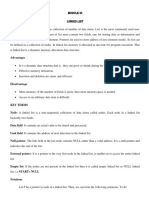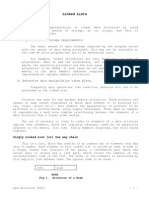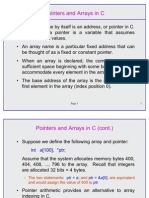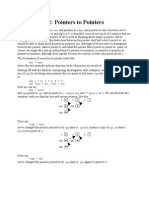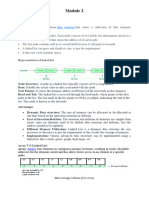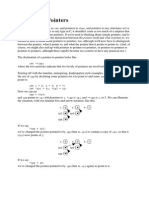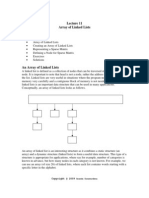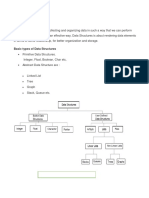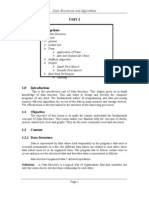List Mat NUB
List Mat NUB
Uploaded by
Isa AhkirasCopyright:
Available Formats
List Mat NUB
List Mat NUB
Uploaded by
Isa AhkirasOriginal Description:
Copyright
Available Formats
Share this document
Did you find this document useful?
Is this content inappropriate?
Copyright:
Available Formats
List Mat NUB
List Mat NUB
Uploaded by
Isa AhkirasCopyright:
Available Formats
Subject:
Data Structure with C
Topic:
List
Introduction list is a finite sequence of data items, i.e. a collection of data items arranged in a certain linear order. he basic operations performed on this data structure are searching for, inserting and deleting an element. There are two specially important types of list. Sacks and Queues.
Figure 1: Stack and Queue A stack is a list in which insertion and deletion can be done only at one end. Such end is called Top, as a result this structure operates in a Last-In-First-Out (LIFO) fashion. A queue is a list from which elements are deleted from one end of the structure, called the front . The new elements are added to the other end, called the rear. As a result this structure operates in a First-In-First-Out (FIFO) fashion. A linear linked list is a sequence of zero or more elements called nodes, these two concepts are illustrated in figure 1. Similarly list is describing in the following section. Each node of list contains two fields, one is an information field and one or more links to the next nodes of the linear list, called next address field. In a singly linked list, each node except the last one contains a single pointer to the next element as shown in the figure 2.
Figure 2: List In the comparable way, it is essential to launch a doubly linked list, each node except the first and the last, contains pointers to both its successor and its predecessor and same is elaborated in the figure 3.
Figure 3: Doubly linked list
ARRAY IMPLEMENTATION OF LISTS As we shown in the previous section, a list is simply collection of nodes, this can be implemented using array of nodes. However the nodes cannot be ordered by the array ordering, each must contain within itself a pointer to its successor, this can be defined in the following way. define NUMNODES 500 struct nodetype { int info, next; }; struct nodetype node[NUMNODES]; Here a pointer is represented by an array index, i.e. pointer is an integer between 0 and NUMNODES-1 that references a particular element of the array node. The null pointer is represented by integer -1. The nodes of a list may be scattered throughout the array node in any arbitrary order. Each node carries within itself the location of its successor until the last node in the list, whose next field contains -1(null pointer). There is no relation between the content of the node and the pointer to it. It merely specifies which element of the array is being referenced. Consider an array node that contains four linked list. The list list1 starts at node[16] and contains the integers 3, 7, 14, 6, 5, 37, 12. The nodes that contain these integers in there info part are scattered throughout the array. The next field of each node contains the index within the array of the node containing the next element of the list. The last node of the list is node[23], which contains the integer 12 in its info field and the null pointer(-1) in its next field, to indicate that it is last on the list. Similarly, list2 starts
at node[4] and contains the integers 17 and 16, list3 starts at node[11] and contains the integers 31, 19, 32 and so on. The variables list1, list2, list3, list4 represents external pointers to the four lists. Thus the fact that the variable list2 has the value 4 represents the fact that the list to which it points begins at node[4]. Array of nodes containing four linked lists and it is shown in the figure 4.
Figure 4: Stack and Queue Initially, all nodes are unused, since no list have yet been formed. Therefore they must be placed in the available list. When a node is needed for use in a particular list, it is obtained from the available list.
Similarly when the node is no longer necessary, it is returned to the available list. These operations are implemented by C routine as getnode and freenode. The function getnode removes a node from the available list an returns a pointer to it. The function freenode accepts a pointer to a node and returns that node to the available list. int getnode(void) { int p; if ( avail == -1 ) { printf(Overflow); exit(1); } p = avail; avail = node[avail].next; return(p); } void freenode(int p) { node[p].next = avail; avail = p; return; } The primitive operations for lists are straightforward. The routine insafter accepts a pointer to a node and an item x as parameters. It first ensures that p is not null and then inserts x into a node following the node pointed to by p. Before calling insafter we must be sure that p is not null. The quite comparable concepts are portrayed in figure 5 and figure 6.
Figure 5: Insertion of node into list
Void insafter(int p, int x) { int q; if( p == -1) { printf(Void Insertion); return; } q = getnode(); node[q].info = x; node[q].next = node[p].next; node[p].next = q; return; }
Figure 6: Insertion of node into list after p The routine delafter(p,px), called by the statement delafter(p,&x), deletes the node following node(p) and stores its contents in x. Before calling delafter we must be sure that neither p nor node[p].next is null and resembling concepts are demonstrated in figure 7 and figure 8.
Figure 7: Deletion of node from a list
Void delafter(int p, int *px) { int q; if( (p == -1) || (node[p].next = -1) ) { printf(Void Deletion); return; } q = node[p].next; *px = node[q].info; node[p].next = node[q].next; freenode(q); return; }
Figure 8: Deletion of node after node p LIMITATIONS OF ARRAY IMPLEMENTATION Under the array implementation, a fixed set of nodes represented by an array is established at the start of execution. A pointer to a node is represented by the relative position of the node within the array. The disadvantage of that approach is twofold First, the number of nodes that are needed cannot be predicted when a program is written. Usually the data with which the program is executed determines the number of nodes necessary. Thus no matter how many elements the array contains, it is always possible that input requires a larger number. Secondly whatever be the number of nodes declared, it is allocated throughout the program execution. Ex: if 500 nodes are declared, the amount of storage required for those nodes is reserved. If the program uses 100 or even 10 nodes, the additional nodes are still reserved and their storage cannot be used for any other purpose
The solution to this problem is to allow nodes that are dynamic, rather than static i.e. when a node is needed, storage is reserved for it, and when it is no longer needed, the storage is released. Thus can be used for another purpose, also, no predefined limit on the number of nodes is established. ALLOCATING AND FREEING DYNAMIC VARIABLES If x is any object, &x is a pointer to x. If p is a pointer, *p is the object to which p points. Once a variable p has been declared as a pointer to a specific type of object, it must be possible to dynamically create an object of that specific type and assign its address to p. This is done by calling the standard library function malloc(size). malloc dynamically allocates a portion of memory of size size and returns a pointer to an item of type char. Consider the following declaration. extern char *malloc(); int *pi; int *pr; pi = (int *) malloc(sizeof(int)); pr = (float *) malloc(sizeof(float)); The above statements dynamically creates the integer variable *pi and the float variable *pr. The sizeof operator returns the size, in bytes, of it operand. malloc can then create an object of that size, which is further illustrated in the figure 9. Thus malloc(sizeof(int)) allocates storage for an integer, whereas malloc(sizeof(float)) allocates storage for a floating point number. int *p, *q, x; p=(int*)malloc(sizeof(int)); *p = 3; q = p; printf(%d%d,*p,*q); x = 7; *q = x; printf(%d%d,*p,*q); p = (int*) malloc(sizeof(int)); p = 5; printf(%d%d,*p,*q);
Figure 9: illustration pointer concept The function free is used to free occupied storage of a dynamically allocated variable. The statement free(p) makes any future references to the variable *p illegal and it is shown in the figure 10. Calling free(p) makes the storage occupied by *p available for reuse, if necessary. p = (int*) malloc(sizeof(int)); *p = 5; q = (int*) malloc(sizeof(int)); *q = 8; free(p); p = q; q = (int*) malloc(sizeof(int)); *q = 6; printf(%d%d, *p,*q);
Figure 10: illustration pointer concept
LINKED LIST USING DYNAMIC VARIABLES The linked list consists of a set of nodes, each of which has two fields: an information field and a pointer to the next node in the list. In addition an external pointer points to the first node in the list. We can define a node as follows. struct node { int info; struct node *next; }; typedef struct node *NODEPTR; A node of this type is similar to the nodes of array implementation, except that the next field is a pointer rather than an integer. Linked list implementation using dynamic allocation: instead of declaring an array to represent an aggregate collection of nodes, nodes are allocated and freed as necessary. The need for a declared collection of nodes is eliminated. If we declare NODEPTR p; execution of the statement p=getnode(); should place the address of an available node into p. NODEPTR getnode(void) { NODEPTR p; p = (NODEPTR) malloc(sizeof(struct node)); return(p); } Execution of the statement freenode(p) should return the node whose address is at p to available storage. void freenode(NODEPTR p) { free(p); } The programmer need not be concerned with managing available storage. There is no longer a need for the pointer avail, since the system governs the allocating and freeing of nodes and the system keeps track of the first available node. The routines insafter(p, x) and delafter(p, px) are implemented as follows. void insafter(NODEPTR p, int x) { NODEPTR q; if( p == NULL) { printf(Void Insertion); exit(1); } q = getnode(); q->info = x;
q->next = p->next; p->next = q; } void delafter(NODEPTR p, int *px) { NODEPTR q; if( ( p == NULL) || (p-> next == NULL)) { printf(Void Deletion); exit(1); } q = p->next; *px = q->info; p->next = q->next; freenode(q); } ------------------- This is end of Ist Lecture session---------------
List (continued)
The nodes are defined with the concept of array and memory efficient thought called dynamic memory. Let we start with array concept and node can defined as follows. #define NUMNODES 250 struct nodetype{ int info, next; }; struct nodetype node[NUMNODES]; Similarly through the dynamic memory concept node can be defined as follows struct node{ int info; struct node *next; }; typedef struct node *NODEPTR; From the above discussion we are able to develop a simple piece of program to implement the queue and it is defined with the concept of array as well as dynamic memory as follows, firstly with array implementation then dynamic memory. struct queue { int front, rear; }; struct queue q;
Dynamic memory representation struct queue { NODEPTR front, rear; }; struct queue q;
Figure 11 : queue representation Maninly front and rear are pointers to the first and last nodes of a queue presented as a list and same is shown in figure 11. The empty queue is represented by front and rear both equaling the null pointer. The function empty need to check only one of these pointers since, in a nonempty queue, neither front nor rear will be NULL. Array implementation shown in the subsequent steps. int empty{struct queue *pq) { return( (pq->front == -1) ? TRUE : FALSE ); } simialarly dynamic implementation defined int empty{struct queue *pq) { return( (pq->front == NULL) ? TRUE : FALSE ); } Operation on List The insert routine attempt to insert an element into a queue may be written as follows and using array implementation code can be, in this way and this further elaborated in figure 12. void insert(struct queue *pq, int x) { int p = getnode(); node[p].info = x; node[p].next = -1; if( pq->rear == -1 ) pq->front = p; else
node[pq->rear].next = p; pq->rear = p; }
Figure 12: structure if queue QUEUES AS LISTS with Insertion operation The most often performing operation over the queues are insertion and deletion. These functions are illustrated using dynamic memory in following paragraph. void insert(struct queue *pq,int x) { NODEPTR p = getnode(); p-.info = x; p-.next = NULL; if( pq->rear == NULL ) pq->front = p; else (pq->rear)->next = p; pq->rear = p; }
QUEUES AS LISTS The routine to remove the first element from a queue and return its value is as follows QUEUES AS LISTS-Remove The remove functions explained with array and dynamic memory. Array Implementation: int remove(struct queue *pq) { int p, x; if( empty(pq) ) { printf(Queue Underflow); exit(1); }
p = pq->front; x = node[p].info; pq->front = node[p].next; if(pq->front == -1) pq->rear = -1; freenode(p); return(x); } Dynamic Implementation: int remove(struct queue *pq) { NODEPTR p; int x; if( empty(pq) ) { printf(Queue Underflow); } p = pq->front; x = p->info; pq->front = p->next; if(pq->front == NULL) pq->rear = NULL; freenode(p); return(x); } List Operations place(*plist, x) : inserts the element x into its appropriate position in the sorted linear list *plist. void place(NODEPTR *plist, int x) { NODEPTR p,q; q = NULL; for(p = *plist; p!=NULL && x > p->info; p = p->next) q = p; if( q == NULL ) push(plist, x); else insafter(q, x); } Insert at End
exit(1);
insend(plist, x) : to insert the element x at the end of a list plist. void insend(NODEPTR *plist,int x) { NODEPTR q, p = getnode(); p->info = x; p->next = NULL; if(*plist == NULL) *plist = p; else{ for(q=*plist;q->next!=NULL;q=q->next) ; q->next = p; } } Search an element search(list , x) : returns a pointer to the first occurrence of x within the list and the NULL pointer if x does not occur in the list. NODEPTR search(NODEPTR list, int x) { NODEPTR p; for(p = list; p!=NULL; p=p->next) if(p->info ==x) return(p); return(NULL); } Remove an Element remvx(plist, x) : removes all the nodes whose info field contains the value x. void remvx(NODEPTR *plist, int x) { NODEPTR p,q; int y; q = NULL; p = *plist; while(p != NULL) if(p->info == x) { p = p->next; if(q == NULL) { freenode(*plist); *plist = p; } else delafter(q, &y); }
else q = p; p = p->next; } } NONINTEGER AND NONHOMOGENEOUS LISTS A node on a list need not represent an integer. Ex: to represent a stack of character strings in their info field are needed. Such nodes using the dynamic allocation implementation could be declared as: struct node { char info[100]; struct node *next; } A particular application may call for nodes containing more than one item of information. Ex: each student node in a list of student may contain the following information: the student name, identification number, grade point index and major. Nodes for such applications may be declared as follows: struct node{ char name[30]; char id[10]; char address[100]; float gpindex; char major[20]; struct node *next; }; To represent nonhomogeneous lists a union can be used in the following example. define INT 1 #define FLT 2 #define STR 3 struct node{ int etype; union { int ival; float *pval char *pval; } element; struct node *next; };
A node whose items may be either integer, floating-point numbers, or strings, depending on the value of the corresponding etype. Since a union is always large enough to hold its largest components, the sizeof and malloc functions can be used to allocate storage for the node. Thus the functions getnode and freenode remain unchanged. It is the programmers responsibility to use the components of a node as appropriate COMPARING THE DYNAMIC AND ARRAY IMPLEMENTATION OF LIST Disadvantage of the dynamic implementation is that it is more time consuming to call upon the system to allocate and free storage than to manipulate a programmer managed available list. Its major advantage can be a set of nodes are not reserved in advance for use by a particular group of lists. Suppose that a program uses tow types of lists which are mainly list of integers and list of characters. Under the array representation, two array of fixed size would immediately be allocated. If one group of lists overflows its array, the program cannot continue. Under the dynamic representation, two type nodes are defined at the outset. But no storage is allocated for variable until needed. As nodes are needed, the system is called upon to provide them. Any storage not used for one type of nodes may be used for another. Thus as long as sufficient storage is available for the node actually presents in the list, no overflow occurs. Any storage not used for one type of nodes may be used for another.
Another advantage of the dynamic implementation is that a reference to *p does not involve the address computation that is necessary in computing the address of node[p]. To compute the address of node[p], the contents of p must be added to the base address of the array node, whereas the address *p is given by the contents of p directly. Disadvantages of arrays: Array implementation for stacks and queues, it allocates a fixed size of memory for that particular stack or queue. So, if more memory is allocated and if we are using a very small memory, the remaining is unnecessarily wasted. Also if the memory allocated is too small and we need much more memory than available then we cannot allocate the extra memory during the execution of the program. Insertion and deletion are complicated in the array implementation because of the data movements from one position to other. if the array is of larger size, insertion operation on
the array has to first slide all the elements one stroke right side and deletion operation has to slide all the elements one stroke left side. Advantages of linked list: Efficient memory utilization: The memory of a linked list is not pre-allocated. Memory can be allocated whatever required. And it is deallocated when it is no longer required. Insertion and deletion operations are easier and efficient : Linked list provide flexibility in inserting a data item at a specified position and deletion of a data item from the given position. Extensive manipulation: we can perform any number of complex manipulations without any prior idea of the memory space available. (i.e. in stacks and queues we sometimes get overflow conditions. Here no such problem arises.) Arbitrary memory locations: here the memory locations need not be consecutive. They may be any arbitrary values. But even then the accessing of these items is easier as each data item contains within itself the address to the next data item. Therefore, the elements in the linked list are ordered not by their physical locations but by their logical links stored as part of the data with the node itself. As they are dynamic data structures, they can grow and shrink during the execution of the program. IMPLEMENTING HEADER NODES Header nodes contain information about a list, such as its length or a pointer to the current or last node on the list. When the data type of the header content is identical to the type of the list-node contents, the header can be implemented simply as just another node at the beginning of the list . Header nodes contain information about a list, such as its length or a pointer to the current or last node on the list. When the data type of the header content is identical to the type of the list-node contents, the header can be implemented simply as just another node at the beginning of the list. It is also possible for the header node to be declared as variables separate from the set of list nodes. This is particularly useful when the header contains information of a different type rather than the data in list nodes. Ex: consider the following set of declarations:
struct node{ char info; struct node *next; }; struct charstr{
int length; struct node *firstchar; }; struct charstr s1,s2; The variables s1 and s2 of the type charstr are header nodes for a list of characters. The header contains the number of characters in the list and a pointer to the list. Thus s1 and s2 represent varying-length character string.
*****
*******
You might also like
- Chapter 5Document34 pagesChapter 5shjdjeNo ratings yet
- EENG212 - Algorithms & Data Structures: Linked ListsDocument4 pagesEENG212 - Algorithms & Data Structures: Linked ListsVincentNo ratings yet
- Chapter 4 ALGODocument11 pagesChapter 4 ALGOethiopia1212 ethoNo ratings yet
- Cs 2208 Data Structures Lab 0 0 3 2 (Repaired)Document33 pagesCs 2208 Data Structures Lab 0 0 3 2 (Repaired)sumiyamini08No ratings yet
- Data StructuresDocument122 pagesData Structurespranav rNo ratings yet
- Linked Lists: Overflow Occurs. No Simple Solution Exists For More Stacks and Queues. in A SequentialDocument8 pagesLinked Lists: Overflow Occurs. No Simple Solution Exists For More Stacks and Queues. in A Sequentialstudy materialNo ratings yet
- DS Module 3Document29 pagesDS Module 3jeevithar048No ratings yet
- What Is Linked List?: Item. Entry Point Into The Linked List Is Called The Head of The ListDocument110 pagesWhat Is Linked List?: Item. Entry Point Into The Linked List Is Called The Head of The ListKam PradeeNo ratings yet
- R23_DS_Unit II-1Document12 pagesR23_DS_Unit II-1bhargavreddy42317No ratings yet
- Circular Linked List Data StructureDocument47 pagesCircular Linked List Data StructureAdrian IosifNo ratings yet
- Paper 1 - Data Structures Using C': Chapter - 1 - IntroductionDocument21 pagesPaper 1 - Data Structures Using C': Chapter - 1 - IntroductionNrgk PrasadNo ratings yet
- Array Vs Linked ListDocument26 pagesArray Vs Linked Listbenzema nunu100% (1)
- Lec-6 List ADT & Linked ListsDocument60 pagesLec-6 List ADT & Linked ListsTaqi ShahNo ratings yet
- Module 3Document25 pagesModule 3singwithalansteeveNo ratings yet
- DS - Linked List Using C++Document18 pagesDS - Linked List Using C++JANARDHANA RAO ALAPATINo ratings yet
- Linked Lists NotesDocument24 pagesLinked Lists NotesshresthNo ratings yet
- Link ListDocument27 pagesLink ListDrRohini SharmaNo ratings yet
- DSU Dhane Master IMP Ans,Document27 pagesDSU Dhane Master IMP Ans,122om4054No ratings yet
- Linked List: Unit IIDocument39 pagesLinked List: Unit IIPraveenkumar KazipetaNo ratings yet
- 3.1 Single Linked ListsDocument14 pages3.1 Single Linked ListspappulaurarockNo ratings yet
- Chapter 17 Linked Lists: Starting Out With C++, 3 EditionDocument67 pagesChapter 17 Linked Lists: Starting Out With C++, 3 EditionrafeshNo ratings yet
- StackDocument14 pagesStackகிருஷ்ண குமார் நல்லுNo ratings yet
- Data Structure Interview QuestionsDocument16 pagesData Structure Interview QuestionsĎarľïng KìrãnNo ratings yet
- DSQAnDocument15 pagesDSQAnkamranshamim45No ratings yet
- Chapter 3 - Linked ListsDocument47 pagesChapter 3 - Linked Listsmishamoamanuel574No ratings yet
- Queue BasicsDocument13 pagesQueue BasicsRajendranbehappyNo ratings yet
- ds keyDocument9 pagesds keyNalini BangaramNo ratings yet
- Chapter 22: Pointers To Pointers: Int CharDocument19 pagesChapter 22: Pointers To Pointers: Int Charrajuyadav44No ratings yet
- UNIT II - DsDocument15 pagesUNIT II - DsKarthiNo ratings yet
- AssignmentDocument6 pagesAssignmentViệt Anh NguyễnNo ratings yet
- CS50 Saptamana 05 Data StructuresDocument13 pagesCS50 Saptamana 05 Data StructuresAlecu IlieNo ratings yet
- Module-3 22 SchemeDocument31 pagesModule-3 22 Schemejexehif373No ratings yet
- Chapter 4 - Linked ListsDocument48 pagesChapter 4 - Linked ListsBethelhem AshenafiNo ratings yet
- Algo Chap 3-5Document153 pagesAlgo Chap 3-5zerihun nanaNo ratings yet
- A Doubly Linked Circular ListDocument7 pagesA Doubly Linked Circular Listkhawar abbasiNo ratings yet
- Introduction of DdsuDocument29 pagesIntroduction of Ddsusatya kambleNo ratings yet
- 12 - Data Structure and Algorithms - Linked ListDocument43 pages12 - Data Structure and Algorithms - Linked ListlaraibNo ratings yet
- Data Structure Calicut University 2nd SemDocument20 pagesData Structure Calicut University 2nd Sembijo6074No ratings yet
- Unit IvDocument24 pagesUnit IvSeshu ChakravarthyNo ratings yet
- DSA Lab FilDocument19 pagesDSA Lab Filalainfabo21No ratings yet
- DSA Exp 3, Mhase Sanchit Kishor, Roll No. 29, Div EDocument20 pagesDSA Exp 3, Mhase Sanchit Kishor, Roll No. 29, Div ESwaraj KhedekarNo ratings yet
- singl linked listDocument22 pagessingl linked listpNo ratings yet
- Pointers To PointersDocument5 pagesPointers To Pointerswingman-001No ratings yet
- List ADTDocument70 pagesList ADTbhuvangatesNo ratings yet
- Data Structure Interview QuestionsDocument17 pagesData Structure Interview Questionsadagalepayale023No ratings yet
- FALLSEM2024-25 ISWE102L TH VL2024250102844 2024-08-07 Reference-Material-IDocument24 pagesFALLSEM2024-25 ISWE102L TH VL2024250102844 2024-08-07 Reference-Material-Ijakeklent262No ratings yet
- Data StructuresDocument32 pagesData StructuresitsmedayalNo ratings yet
- Data StructuresDocument15 pagesData Structuresnishanthchandran782No ratings yet
- Array of Linked Lists: Ananda GunawardenaDocument7 pagesArray of Linked Lists: Ananda GunawardenaWesley LoveNo ratings yet
- Linked ListsDocument29 pagesLinked ListsgdskumarNo ratings yet
- Lab3 - Linked List - SolutionDocument10 pagesLab3 - Linked List - Solutiondemro channelNo ratings yet
- Lab 03Document8 pagesLab 03Shakeel AhmadNo ratings yet
- Single Lin ListDocument35 pagesSingle Lin ListSumant ReddyNo ratings yet
- Data Structure Lab Manual Aim & AlgoDocument73 pagesData Structure Lab Manual Aim & AlgoidealmanjuNo ratings yet
- DataStructure LMN PDFDocument8 pagesDataStructure LMN PDFShivam TrivediNo ratings yet
- Unit - IDocument36 pagesUnit - IJit AggNo ratings yet
- 50 Kash Sharma DSDocument37 pages50 Kash Sharma DSKash SharmaNo ratings yet
- linkedlistDocument19 pageslinkedlistf.t.tasnooNo ratings yet
- ADVANCED DATA STRUCTURES FOR ALGORITHMS: Mastering Complex Data Structures for Algorithmic Problem-Solving (2024)From EverandADVANCED DATA STRUCTURES FOR ALGORITHMS: Mastering Complex Data Structures for Algorithmic Problem-Solving (2024)No ratings yet













